
Zendesk Shareholder Letter Q3 2019 -

Introduction We surpassed two major milestones during the third quarter. Our annual revenue run rate* at the end of the quarter exceeded $800 million, and our number of paid customer accounts crossed 150,000. These two milestones speak to the important strategic partner Zendesk has become for organizations as they seek to provide the best customer experiences. As more and more organizations worldwide seek to transform their businesses around their customers, demand for our customer experience products increases. Since our last shareholder letter, we continued to For the third quarter, we delivered revenue of $210.5 advance our product and platform features, million, up 36% year-over-year. With customers in introduce new product innovation, and further build more than 160 countries and territories, our revenue our go-to-market initiatives. Zendesk Sunshine, our is broad-based across SMB, midsized, and enterprise open and flexible CRM platform, has gained customers and grew in every region compared to the momentum with our current customers and we are same period last year. Revenue increased by 41% in seeing customers, partners, and developers in early the U.S., 29% in EMEA, 27% in APAC, and 45% in stages of exploration, design, and implementation. other regions, compared to a year ago. We are keenly We will continue to develop and deliver on our focused on sales and marketing execution as we Sunshine vision in 2020. At our Showcase San manage macroeconomic challenges in some regions Francisco event in October, we announced the of the world, particularly in EMEA and APAC. launch of Sunshine Conversations, an API developer platform that will enable organizations to deliver the Our growth was driven in large part by our future of conversational business, and Zendesk omnichannel solutions, including The Zendesk Suite, Gather, a new community product to provide trusted which is now in use by more than 5,000 customers. and transparent support at scale. We maintained solid growth in our SMB business and also continued our move upmarket with enterprise We are well on our way to achieving our objective customers. During the quarter, the percentage of our to deliver $1 billion in revenue in 2020. We believe annual recurring revenue from customers with 100 we are in a strong position to lead CRM innovation or more Zendesk Support agents was 42% versus and become a multibillion-dollar revenue company 40% a year ago. Our dollar-based net expansion rate over the long-term. remained healthy at 116%. *Annual revenue run rate was calculated by multiplying our Q3-19 revenue by four. For more information about our Zendesk Shareholder Letter Q3 2019 - 2 revenue run rate, please see the “About Operating Metrics” section at the back of this letter.
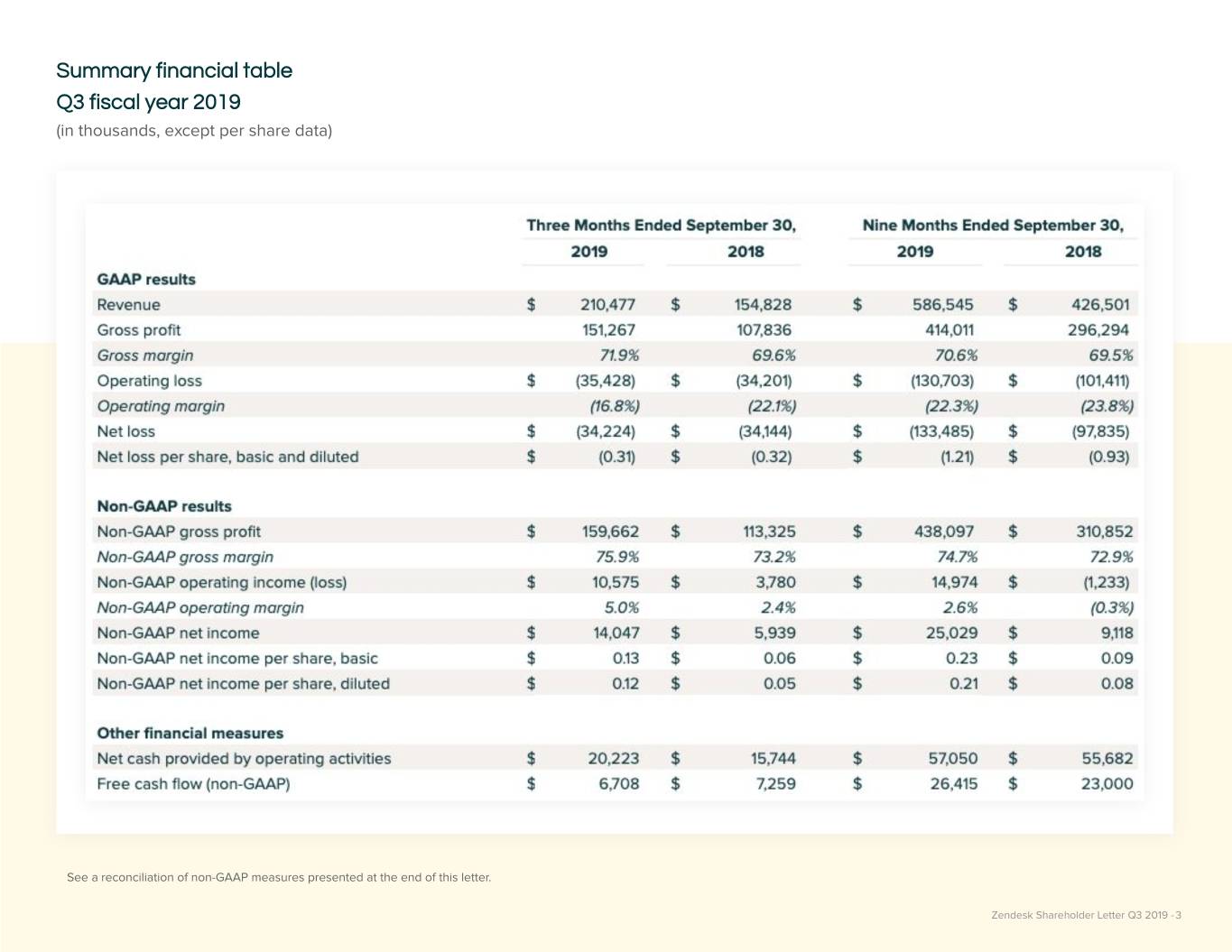
Summary financial table Q3 fiscal year 2019 (in thousands, except per share data) See a reconciliation of non-GAAP measures presented at the end of this letter. Zendesk Shareholder Letter Q3 2019 - 3

Investing for growth The customer experience industry is rapidly evolving. Customers are demanding convenient experiences and fast, easy service across an ever-widening spectrum of social and mobile channels. They expect businesses to be responsive, transparent, and to use data responsibly to improve the customer experience. Our products and platform help organizations do this by providing a broader view of the customer, measuring customer satisfaction, and enabling companies to be on the channels their customers want to be on. Zendesk helps customers architect their businesses around their customers so that they can keep up with evolving customer expectations. We estimate that over the past year, nearly 900 million requesters* engaged with businesses and organizations on our products and platform. Customer story We continue to make the investments in our products and platform that Ingram Micro we believe will set us up for continued leadership in CRM innovation, sustained high growth, and entry into new markets. These investments With its vast global infrastructure and focus on cloud, mobility, include the following: technology lifecycle, supply chain and technology solutions, ● powering every customer-facing conversation for our customers; Ingram Micro enables business partners to operate more ● extending our footprint in support and beyond; efficiently and successfully in the markets they serve. The ● leveraging smarter, faster technologies for better customer company will roll out Zendesk Support, Zendesk Explore, and experiences; Zendesk Collaboration to an initial 250 employees to simplify ● and redefining customer experience through our CRM platform, complex internal and external communication streams. Ingram Zendesk Sunshine. Micro believes Zendesk’s integrated solution will enable the company to easily improve the email experience and response We have made great progress against these initiatives. Some times for its customers. highlights include implementing new use cases for Sunshine; expanding the Sunshine platform into conversational business and messaging with Sunshine Conversations; launching our communities product, Gather; and making app integrations available for Zendesk Sell on the same framework as Zendesk Support. We also expanded our partner network and launched the Zendesk Partner Program. *Nearly 900 million requesters from October 1, 2018 to September 30, 2019, which reflects the Zendesk Shareholder Letter Q3 2019 - 4 number of requester identifications within a customer account. These numbers have not been de-duped across multiple customer accounts.
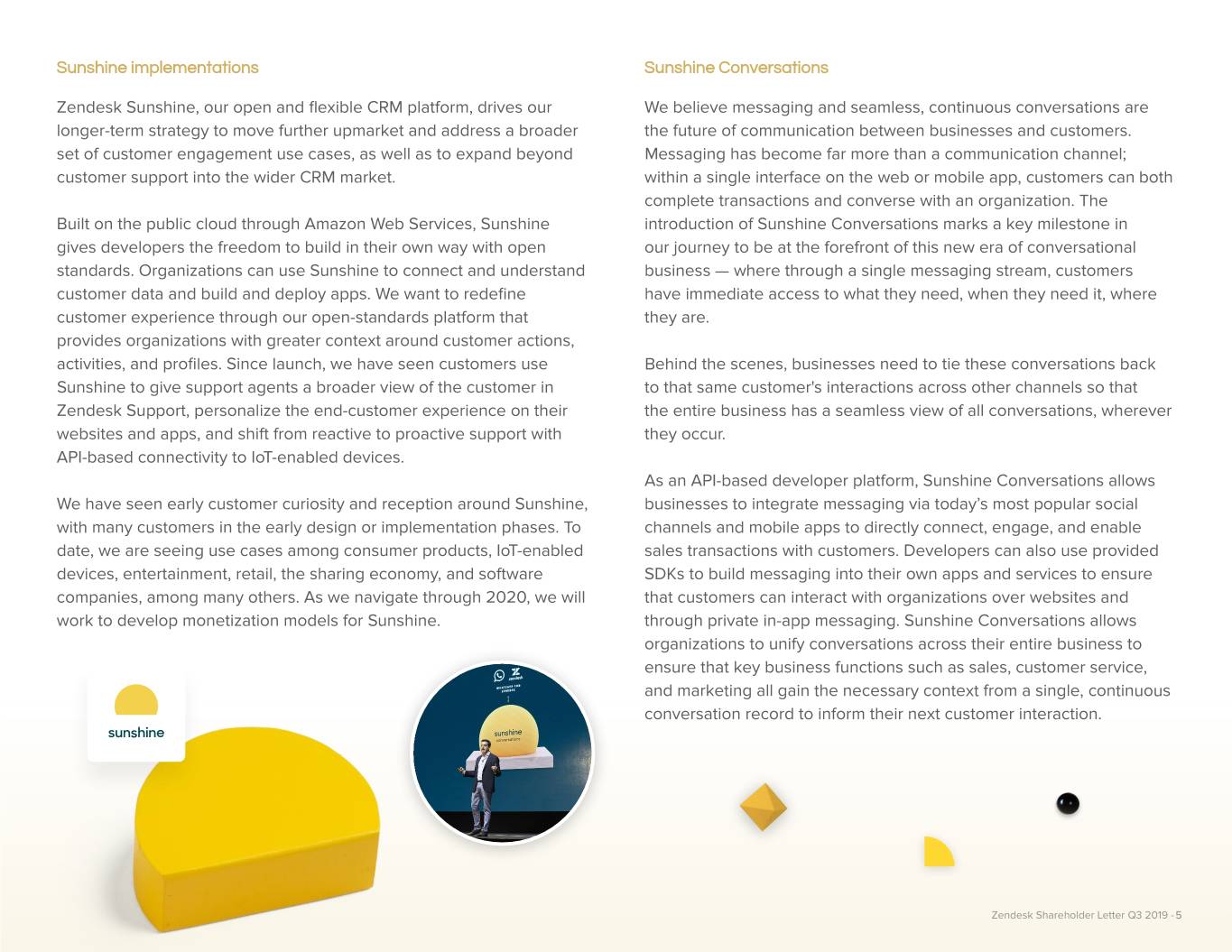
Sunshine implementations Sunshine Conversations Zendesk Sunshine, our open and flexible CRM platform, drives our We believe messaging and seamless, continuous conversations are longer-term strategy to move further upmarket and address a broader the future of communication between businesses and customers. set of customer engagement use cases, as well as to expand beyond Messaging has become far more than a communication channel; customer support into the wider CRM market. within a single interface on the web or mobile app, customers can both complete transactions and converse with an organization. The Built on the public cloud through Amazon Web Services, Sunshine introduction of Sunshine Conversations marks a key milestone in gives developers the freedom to build in their own way with open our journey to be at the forefront of this new era of conversational standards. Organizations can use Sunshine to connect and understand business — where through a single messaging stream, customers customer data and build and deploy apps. We want to redefine have immediate access to what they need, when they need it, where customer experience through our open-standards platform that they are. provides organizations with greater context around customer actions, activities, and profiles. Since launch, we have seen customers use Behind the scenes, businesses need to tie these conversations back Sunshine to give support agents a broader view of the customer in to that same customer's interactions across other channels so that Zendesk Support, personalize the end-customer experience on their the entire business has a seamless view of all conversations, wherever websites and apps, and shift from reactive to proactive support with they occur. API-based connectivity to IoT-enabled devices. As an API-based developer platform, Sunshine Conversations allows We have seen early customer curiosity and reception around Sunshine, businesses to integrate messaging via today’s most popular social with many customers in the early design or implementation phases. To channels and mobile apps to directly connect, engage, and enable date, we are seeing use cases among consumer products, IoT-enabled sales transactions with customers. Developers can also use provided devices, entertainment, retail, the sharing economy, and software SDKs to build messaging into their own apps and services to ensure companies, among many others. As we navigate through 2020, we will that customers can interact with organizations over websites and work to develop monetization models for Sunshine. through private in-app messaging. Sunshine Conversations allows organizations to unify conversations across their entire business to ensure that key business functions such as sales, customer service, and marketing all gain the necessary context from a single, continuous conversation record to inform their next customer interaction. Zendesk Shareholder Letter Q3 2019 - 5
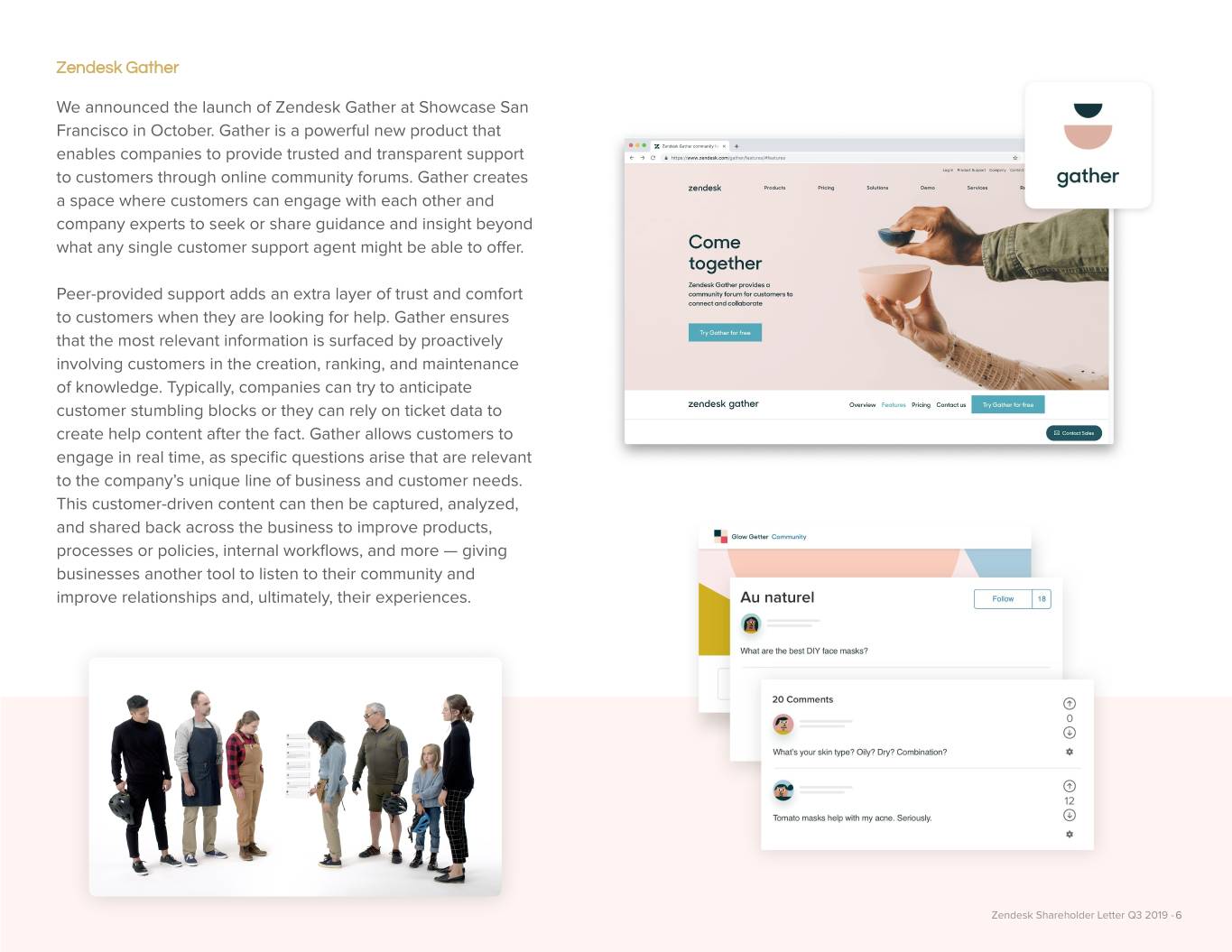
Zendesk Gather We announced the launch of Zendesk Gather at Showcase San Francisco in October. Gather is a powerful new product that enables companies to provide trusted and transparent support to customers through online community forums. Gather creates a space where customers can engage with each other and company experts to seek or share guidance and insight beyond what any single customer support agent might be able to offer. Peer-provided support adds an extra layer of trust and comfort to customers when they are looking for help. Gather ensures that the most relevant information is surfaced by proactively involving customers in the creation, ranking, and maintenance of knowledge. Typically, companies can try to anticipate customer stumbling blocks or they can rely on ticket data to create help content after the fact. Gather allows customers to engage in real time, as specific questions arise that are relevant to the company’s unique line of business and customer needs. This customer-driven content can then be captured, analyzed, and shared back across the business to improve products, processes or policies, internal workflows, and more — giving businesses another tool to listen to their community and improve relationships and, ultimately, their experiences. Zendesk Shareholder Letter Q3 2019 - 6

Zendesk Sell Zendesk Sell, our sales force automation software, puts conversations at the center of the sales experience. Whether in the mobile app or on the web, all prior conversations with customers and prospects are easy to find and pick up again. This summer, we introduced Zendesk Duet, which brings the Support and Sell products closer together, uniting customer service and sales teams. Beginning at Showcase San Francisco, the Zendesk App Framework also became available for Sell. This enables Sell to use the same framework for third-party apps as Support, making it easier to provide context into customer conversations across teams and systems. Customer story ChartMogul ChartMogul offers a SaaS subscription analytics platform that consolidates and aggregates data from across connected billing systems, serving up the most valuable metrics and insights that subscription-based businesses need. The company switched from a competitor to Zendesk Support in 2016 to provide streamlined customer service across all channels, and to feed service data back to the engineering organization. Since then, ChartMogul has also adopted Zendesk Guide and Zendesk Sell. Zendesk has allowed ChartMogul to meet SLAs, scale support and volume in real time, and now to connect its service and sales teams in a single, secure CRM system that is supported by a mobile app and robust reporting functions. Zendesk Shareholder Letter Q3 2019 - 7

Zendesk Partner Program Partners also recognize the opportunity to help businesses transform and redesign their customer experiences using Zendesk's products. Our partner business continues to grow as we now have an ecosystem of more than 1,200 authorized partners, which is 60% more than a year ago. To support our expanding partner ecosystem, we recently launched a new Zendesk Partner Program. This program builds upon our prior initiatives and provides partners with the skills, tools, and assistance they need to enable their customers to deliver a better customer experience using Zendesk. The program is designed to help partners build an industry-leading customer experience practice and it rewards partners based on competencies and results through a comprehensive certification program and other incentives. At the same time, the Zendesk Partner Program can be tailored to meet the needs of different partners’ business models and is flexible enough to support partners as their businesses evolve. Zendesk Shareholder Letter Q3 2019 - 8
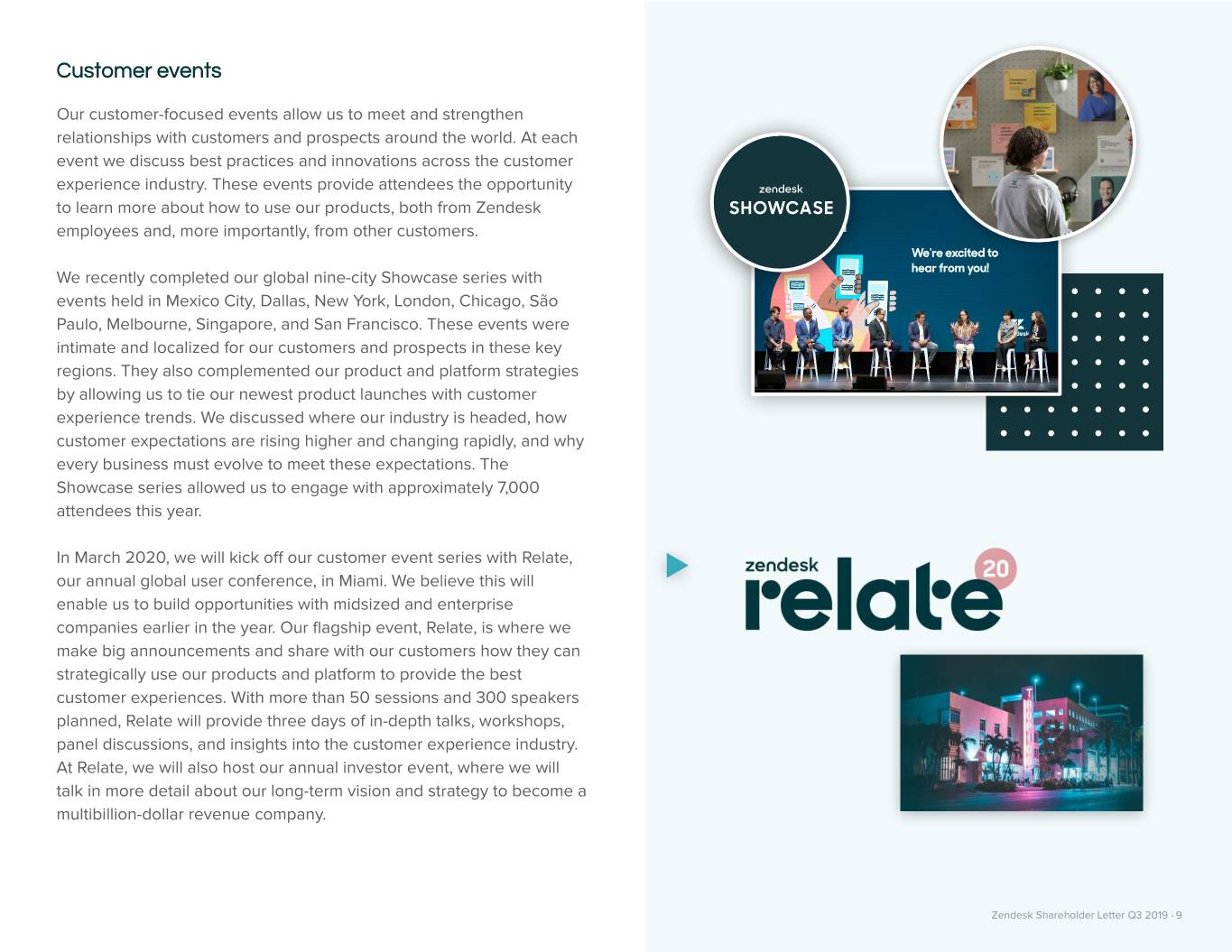
Customer events Our customer-focused events allow us to meet and strengthen relationships with customers and prospects around the world. At each event we discuss best practices and innovations across the customer experience industry. These events provide attendees the opportunity to learn more about how to use our products, both from Zendesk employees and, more importantly, from other customers. We recently completed our global nine-city Showcase series with events held in Mexico City, Dallas, New York, London, Chicago, São Paulo, Melbourne, Singapore, and San Francisco. These events were intimate and localized for our customers and prospects in these key regions. They also complemented our product and platform strategies by allowing us to tie our newest product launches with customer experience trends. We discussed where our industry is headed, how customer expectations are rising higher and changing rapidly, and why every business must evolve to meet these expectations. The Showcase series allowed us to engage with approximately 7,000 attendees this year. In March 2020, we will kick off our customer event series with Relate, our annual global user conference, in Miami. We believe this will enable us to build opportunities with midsized and enterprise companies earlier in the year. Our flagship event, Relate, is where we make big announcements and share with our customers how they can strategically use our products and platform to provide the best customer experiences. With more than 50 sessions and 300 speakers planned, Relate will provide three days of in-depth talks, workshops, panel discussions, and insights into the customer experience industry. At Relate, we will also host our annual investor event, where we will talk in more detail about our long-term vision and strategy to become a multibillion-dollar revenue company. Zendesk Shareholder Letter Q3 2019 - 9
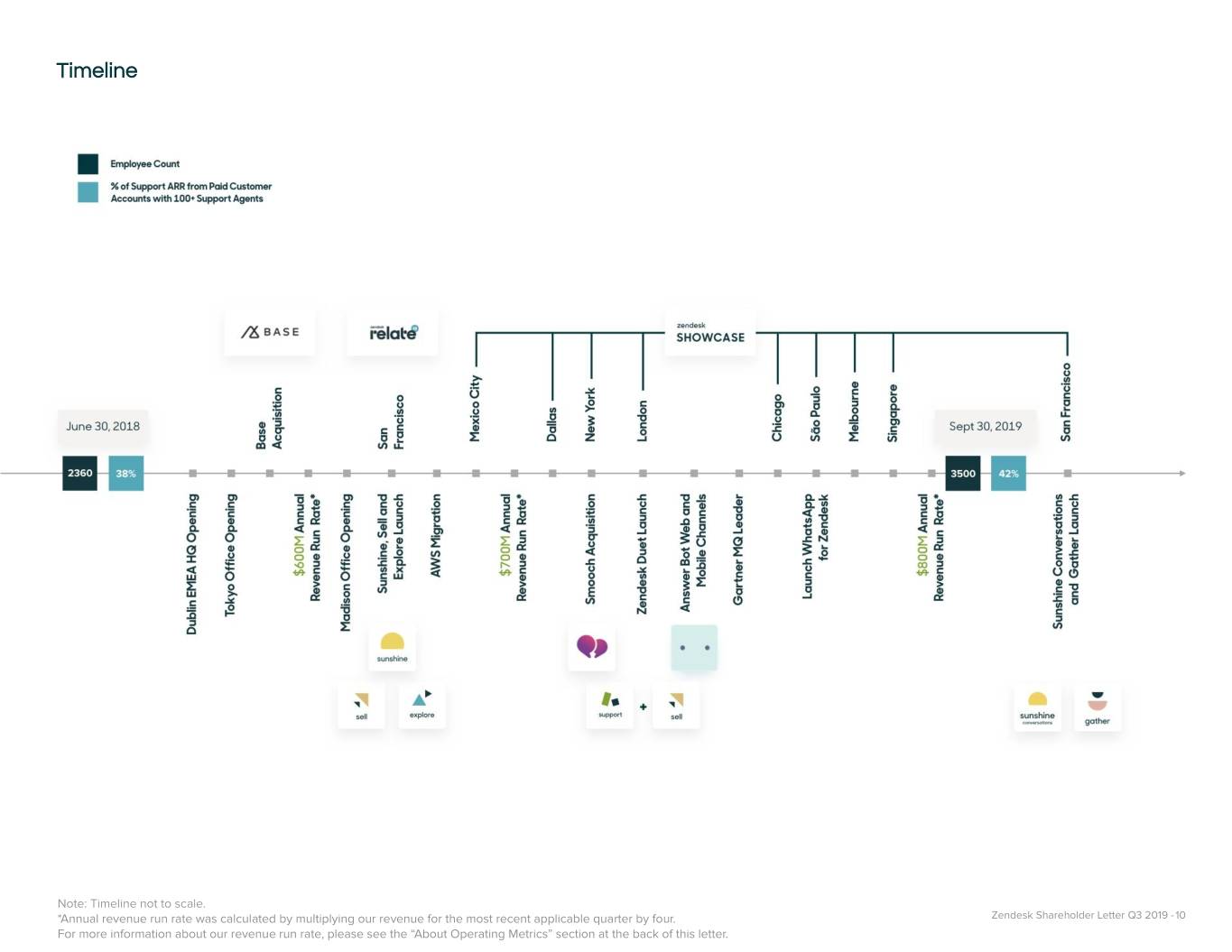
Timeline Note: Timeline not to scale. *Annual revenue run rate was calculated by multiplying our revenue for the most recent applicable quarter by four. Zendesk Shareholder Letter Q3 2019 - 10 For more information about our revenue run rate, please see the “About Operating Metrics” section at the back of this letter.
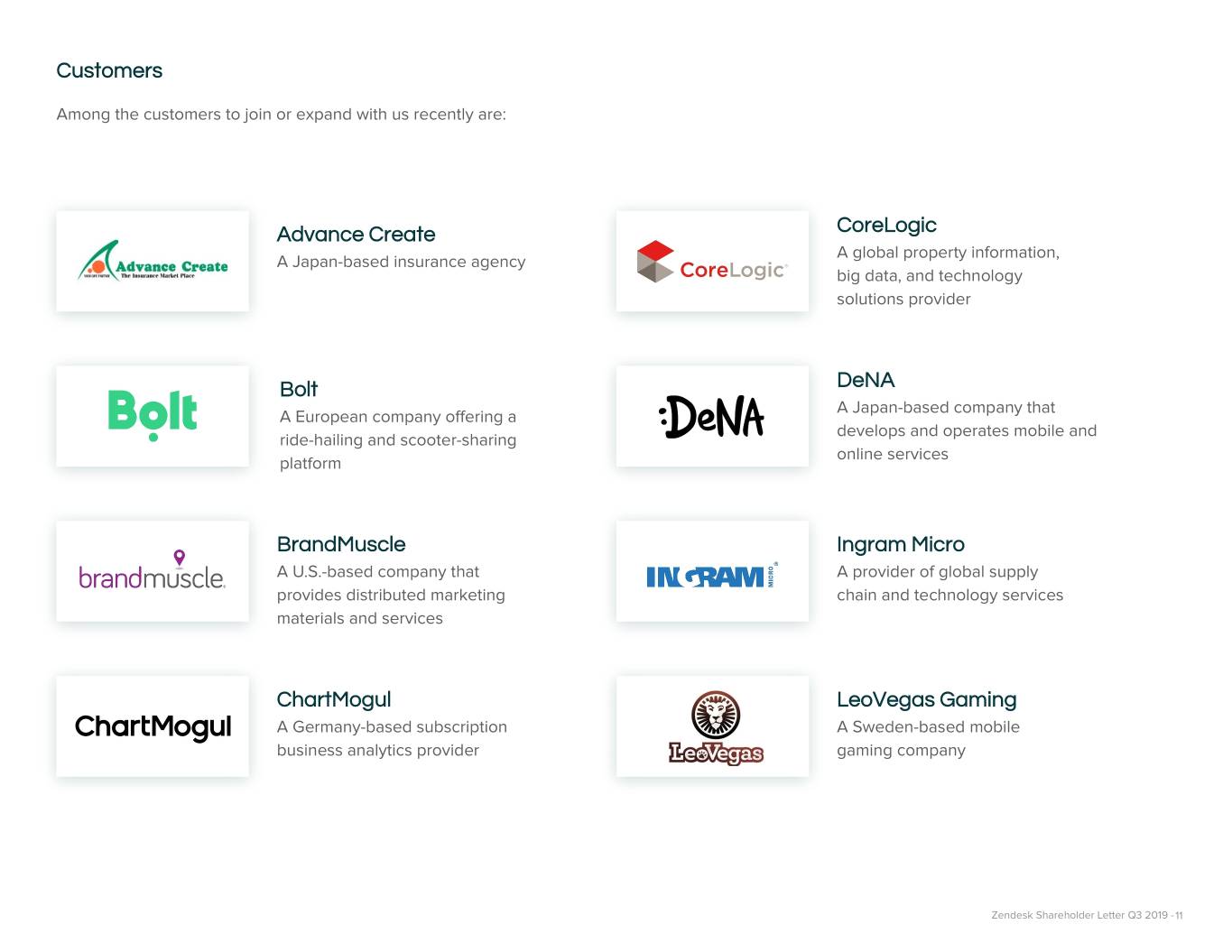
Customers Among the customers to join or expand with us recently are: Advance Create CoreLogic A global property information, A Japan-based insurance agency big data, and technology solutions provider Bolt DeNA A Japan-based company that A European company offering a develops and operates mobile and ride-hailing and scooter-sharing online services platform BrandMuscle Ingram Micro A U.S.-based company that A provider of global supply provides distributed marketing chain and technology services materials and services ChartMogul LeoVegas Gaming A Germany-based subscription A Sweden-based mobile business analytics provider gaming company Zendesk Shareholder Letter Q3 2019 - 11

Customers Social Finance (SoFi) Among the customers to join or expand with us recently are: A U.S.-based company that provides a range of financial services Luna SonarMD A company that offers care A language services provider coordination and therapeutic optimization solution for high-beta conditions The Melting Pot Structo A company that offers fondue A dental 3D printing solutions provider dining experiences Netwealth Track & Field An Australia-based wealth A Brazil-based sportswear company management company P.C. Richard and Son TravelPerk A chain of private, family owned A business travel booking and electronics and appliances stores management company Zendesk Shareholder Letter Q3 2019 - 12
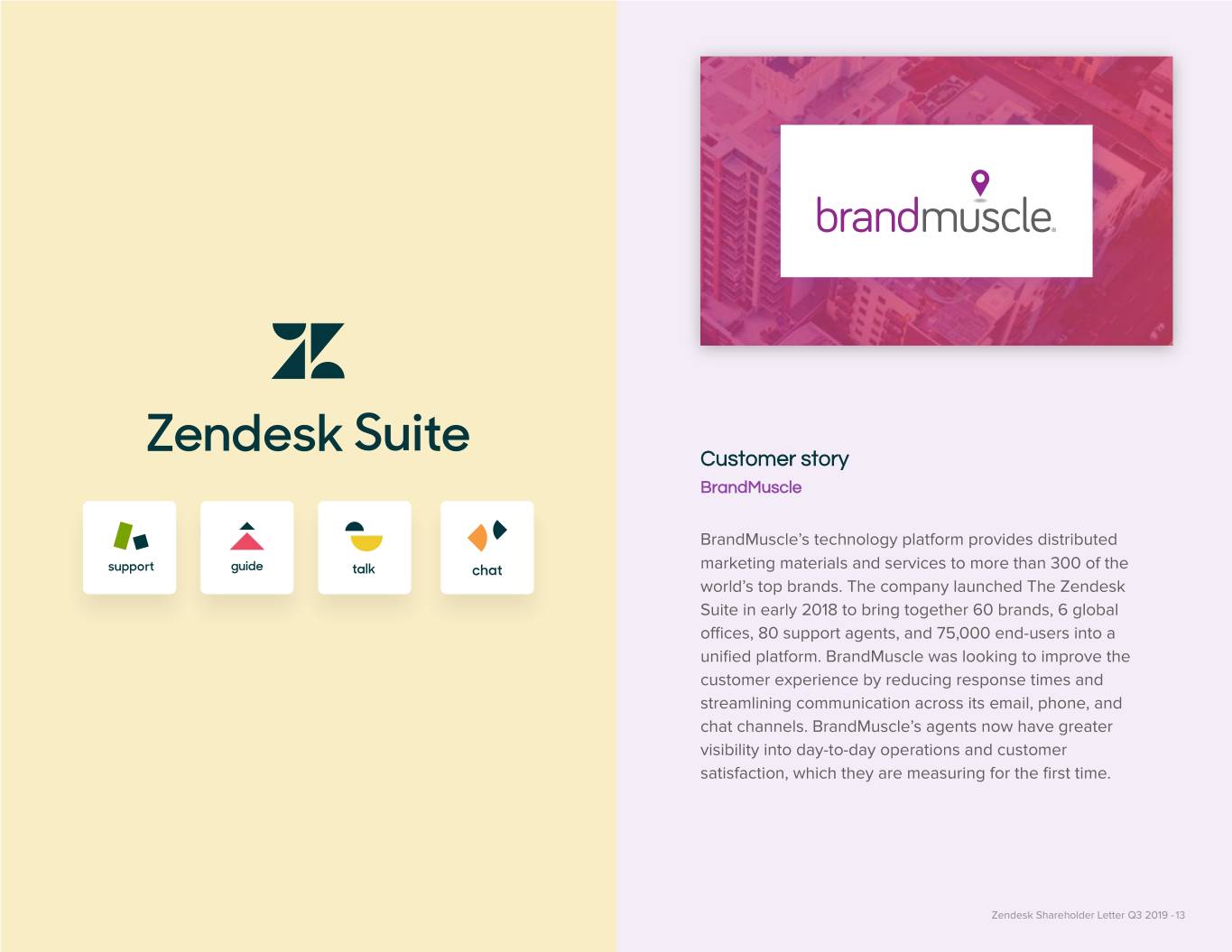
Customer story BrandMuscle BrandMuscle’s technology platform provides distributed marketing materials and services to more than 300 of the world’s top brands. The company launched The Zendesk Suite in early 2018 to bring together 60 brands, 6 global offices, 80 support agents, and 75,000 end-users into a unified platform. BrandMuscle was looking to improve the customer experience by reducing response times and streamlining communication across its email, phone, and chat channels. BrandMuscle’s agents now have greater visibility into day-to-day operations and customer satisfaction, which they are measuring for the first time. Zendesk Shareholder Letter Q3 2019 - 13

In September 2019, Zendesk was mentioned as a Customers' Choice in the Gartner Peer Insights “Voice of the Customer”: CRM Customer Engagement Center Disclaimer: Gartner Peer Insights Customers’ Choice constitute the subjective opinions of individual end-user reviews, ratings, and data applied against a documented methodology; they neither represent the views of, nor constitute an endorsement by, Gartner or its affiliates. The Gartner References described herein, (the “Gartner References”) represent(s) research opinion or viewpoints published, as part of a syndicated subscription service, by Gartner, Inc. (“Gartner”) and are not representations of fact. Each Gartner Reference speaks as of its original publication date (and not as of the date of this Shareholder Letter), and the opinions expressed in the Gartner References are subject to change without notice. Zendesk Shareholder Letter Q3 2019 - 14
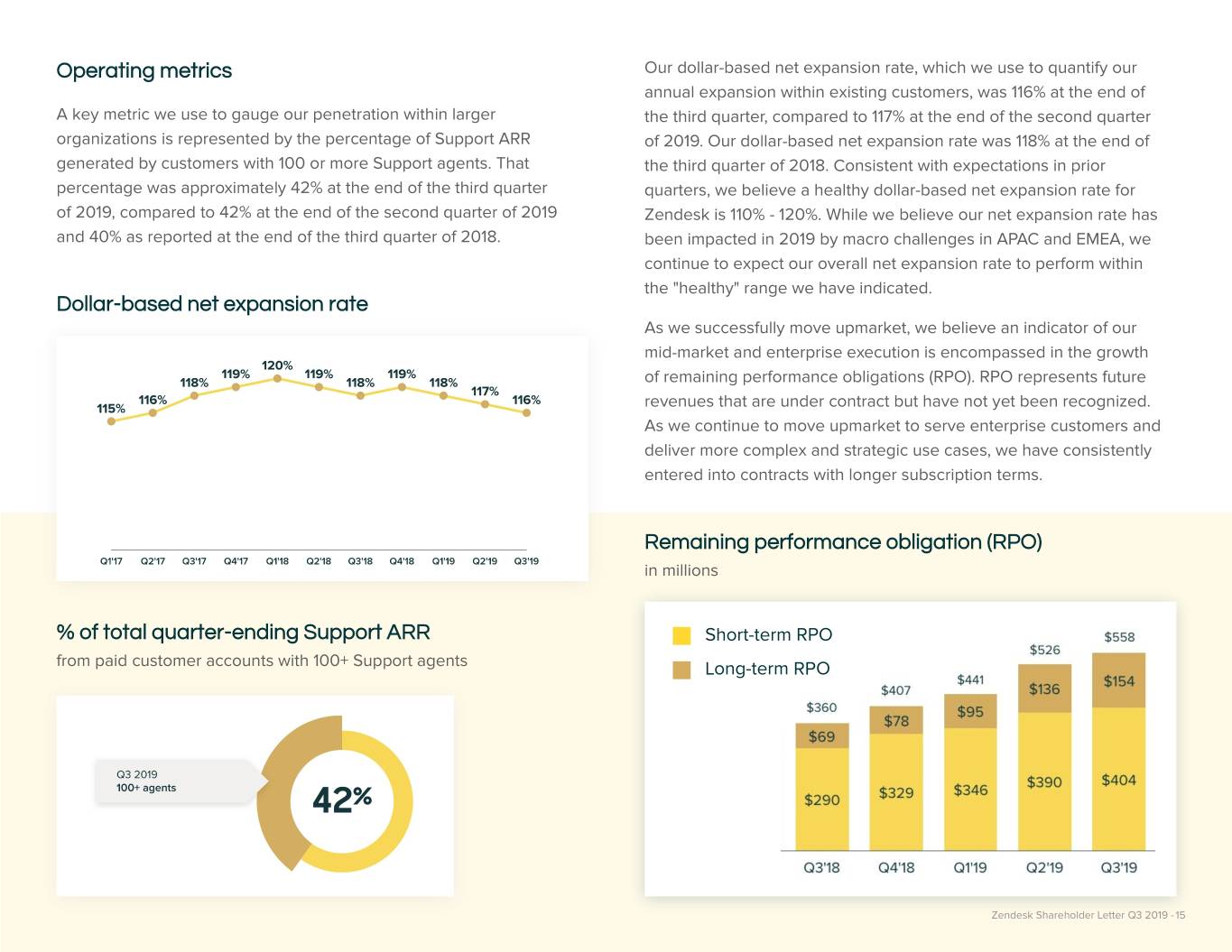
Operating metrics Our dollar-based net expansion rate, which we use to quantify our annual expansion within existing customers, was 116% at the end of A key metric we use to gauge our penetration within larger the third quarter, compared to 117% at the end of the second quarter organizations is represented by the percentage of Support ARR of 2019. Our dollar-based net expansion rate was 118% at the end of generated by customers with 100 or more Support agents. That the third quarter of 2018. Consistent with expectations in prior percentage was approximately 42% at the end of the third quarter quarters, we believe a healthy dollar-based net expansion rate for of 2019, compared to 42% at the end of the second quarter of 2019 Zendesk is 110% - 120%. While we believe our net expansion rate has and 40% as reported at the end of the third quarter of 2018. been impacted in 2019 by macro challenges in APAC and EMEA, we continue to expect our overall net expansion rate to perform within the "healthy" range we have indicated. Dollar-based net expansion rate As we successfully move upmarket, we believe an indicator of our mid-market and enterprise execution is encompassed in the growth of remaining performance obligations (RPO). RPO represents future revenues that are under contract but have not yet been recognized. As we continue to move upmarket to serve enterprise customers and deliver more complex and strategic use cases, we have consistently entered into contracts with longer subscription terms. Remaining performance obligation (RPO) in millions % of total quarter-ending Support ARR Short-term RPO from paid customer accounts with 100+ Support agents Long-term RPO Zendesk Shareholder Letter Q3 2019 - 15

Social impact Social impact has long been a foundational element of Zendesk’s Some examples of recent volunteer efforts by our employees culture and brand. Promoting empathy to solve complex social include working with our local communities to make technology issues is core to our values, as we believe it is an important way more accessible and easier to use. In San Francisco, we have for employees to engage with work, our customers, and our partnered with Curry Senior Center to take seniors on virtual communities around the globe. reality tours. In Madison, we work with the Goodman Community Center to provide trainings to help seniors learn computer skills Our goals for social impact fall into three core areas: being a good and connect digitally. In Singapore, our teams work with neighbor, which focuses on the employee experience of investing Movement for the Intellectually Disabled of Singapore to design in their communities by volunteering; standing up for equality, digital books for adults with intellectual disabilities to read where we will make key investments and strive to support and alongside volunteers and their families. nurture diverse workplaces and communities; and democratizing technology, where we aim to bring technology to organizations committed to social change. As part of these goals, Zendesk employees have committed to giving six hours of their time volunteering in their communities each year. In the first nine months of 2019, Zendesk employees volunteered more than 15,500 hours in their local communities. Zendesk Shareholder Letter Q3 2019 - 16

Select financial measures (in millions, except per share data) Quarter-over-quarter comparisons (q/q) are for the three months ended September 30, 2019, compared to the three months ended June 30, 2019. Year-over-year comparisons (y/y) are for the three months ended September 30, 2019, compared to the three months ended September 30, 2018. See a reconciliation of non-GAAP measures presented at the end of this letter. Zendesk Shareholder Letter Q3 2019 - 17
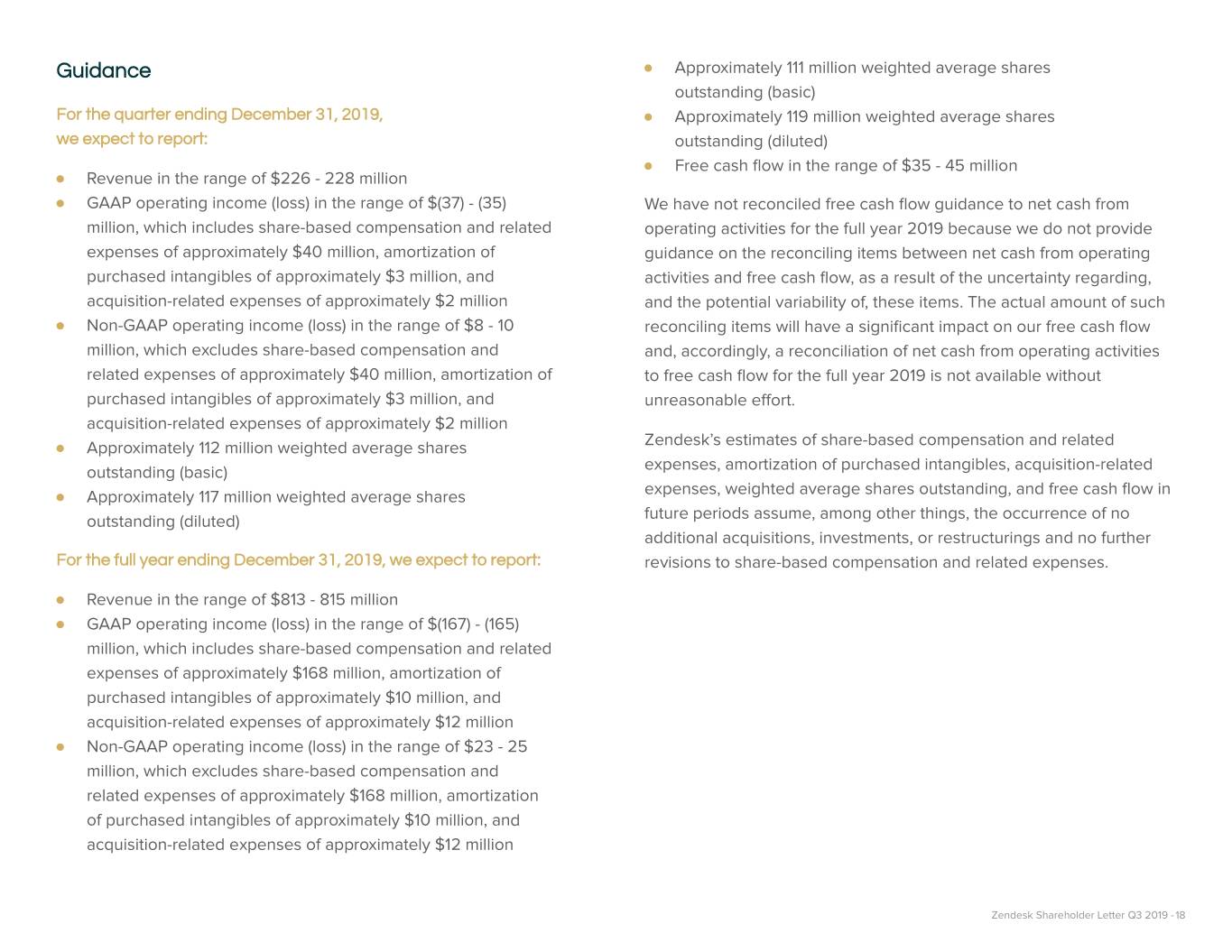
Guidance ● Approximately 111 million weighted average shares outstanding (basic) For the quarter ending December 31, 2019, ● Approximately 119 million weighted average shares we expect to report: outstanding (diluted) ● Free cash flow in the range of $35 - 45 million ● Revenue in the range of $226 - 228 million ● GAAP operating income (loss) in the range of $(37) - (35) We have not reconciled free cash flow guidance to net cash from million, which includes share-based compensation and related operating activities for the full year 2019 because we do not provide expenses of approximately $40 million, amortization of guidance on the reconciling items between net cash from operating purchased intangibles of approximately $3 million, and activities and free cash flow, as a result of the uncertainty regarding, acquisition-related expenses of approximately $2 million and the potential variability of, these items. The actual amount of such ● Non-GAAP operating income (loss) in the range of $8 - 10 reconciling items will have a significant impact on our free cash flow million, which excludes share-based compensation and and, accordingly, a reconciliation of net cash from operating activities related expenses of approximately $40 million, amortization of to free cash flow for the full year 2019 is not available without purchased intangibles of approximately $3 million, and unreasonable effort. acquisition-related expenses of approximately $2 million ● Approximately 112 million weighted average shares Zendesk’s estimates of share-based compensation and related outstanding (basic) expenses, amortization of purchased intangibles, acquisition-related ● Approximately 117 million weighted average shares expenses, weighted average shares outstanding, and free cash flow in outstanding (diluted) future periods assume, among other things, the occurrence of no additional acquisitions, investments, or restructurings and no further For the full year ending December 31, 2019, we expect to report: revisions to share-based compensation and related expenses. ● Revenue in the range of $813 - 815 million ● GAAP operating income (loss) in the range of $(167) - (165) million, which includes share-based compensation and related expenses of approximately $168 million, amortization of purchased intangibles of approximately $10 million, and acquisition-related expenses of approximately $12 million ● Non-GAAP operating income (loss) in the range of $23 - 25 million, which excludes share-based compensation and related expenses of approximately $168 million, amortization of purchased intangibles of approximately $10 million, and acquisition-related expenses of approximately $12 million Zendesk Shareholder Letter Q3 2019 - 18
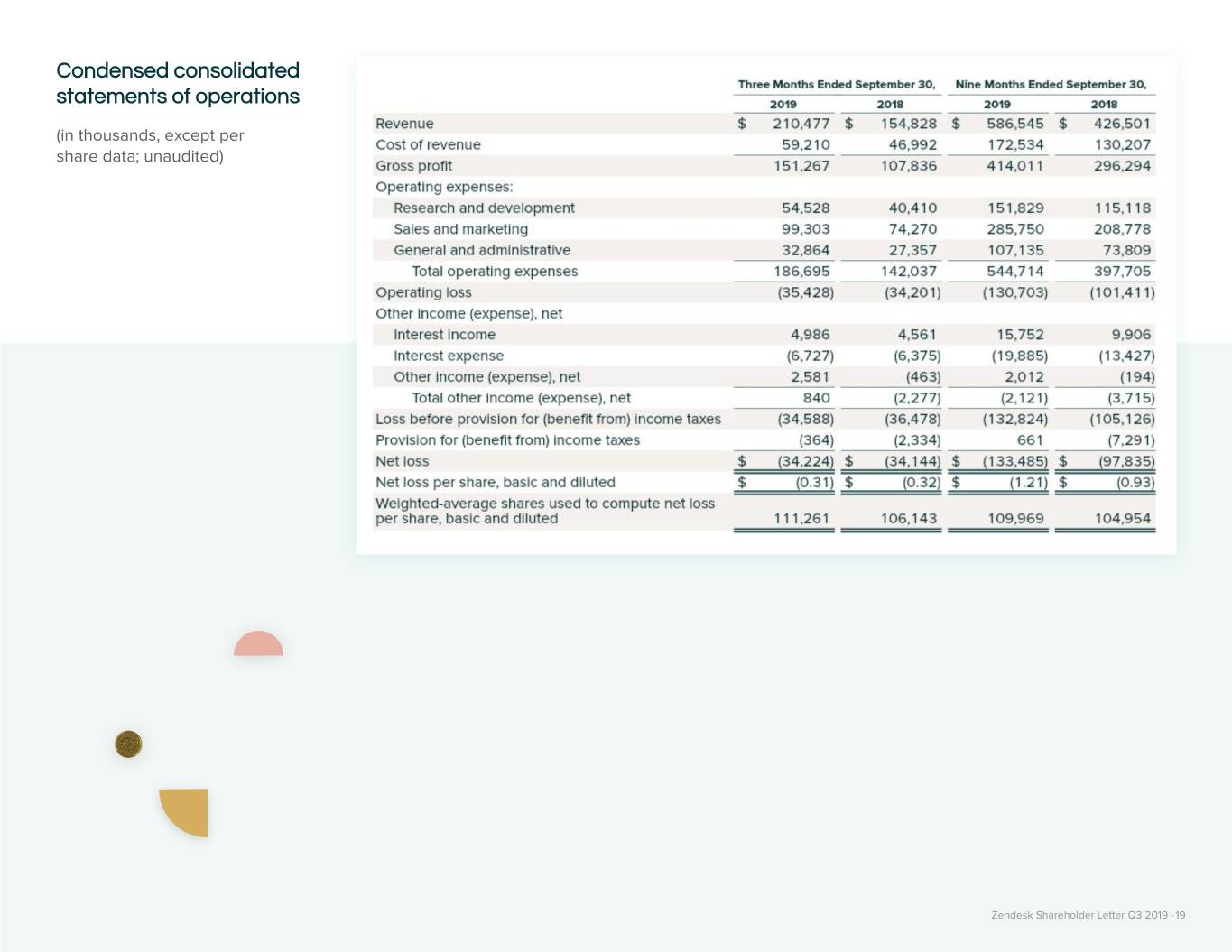
Condensed consolidated statements of operations (in thousands, except per share data; unaudited) Zendesk Shareholder Letter Q3 2019 - 19
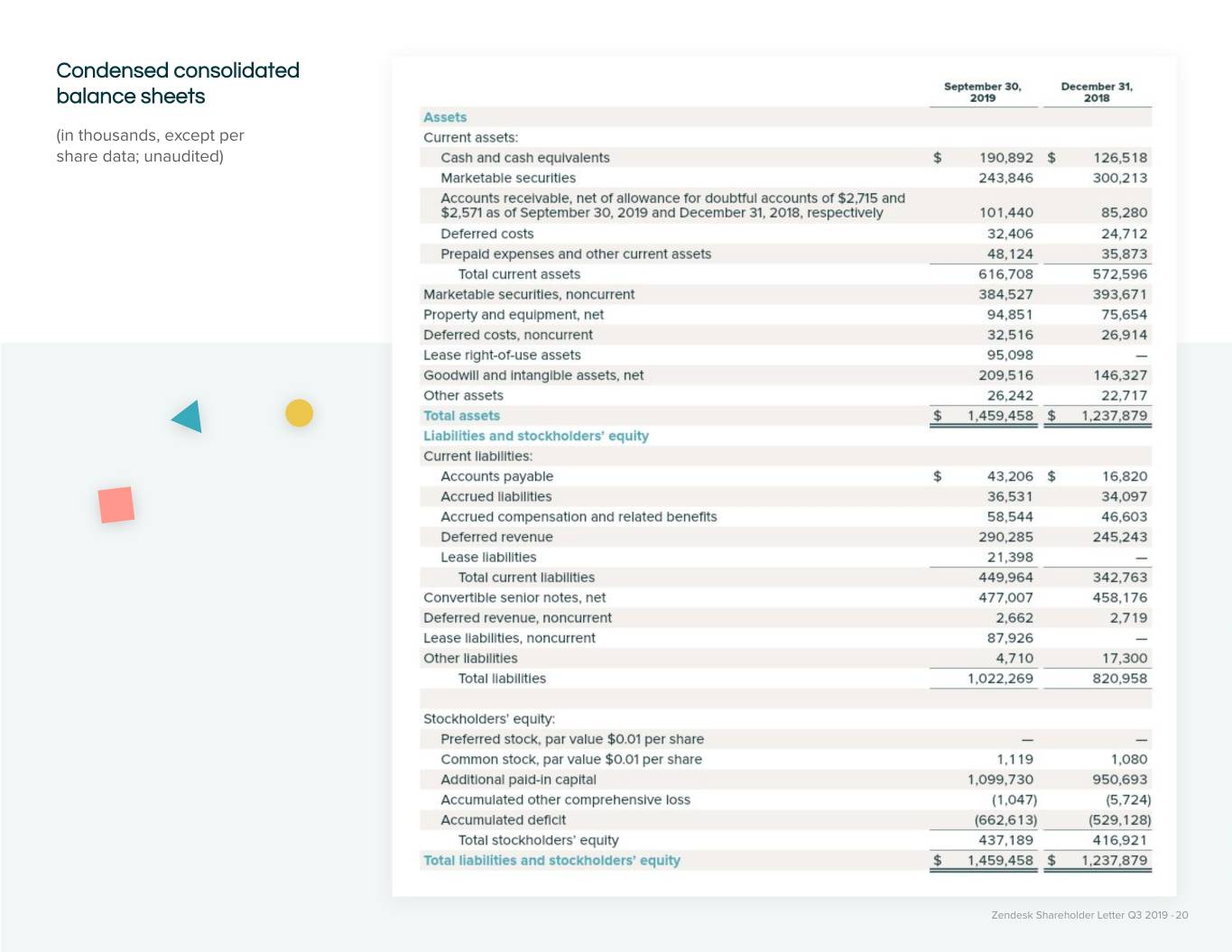
Condensed consolidated balance sheets (in thousands, except per share data; unaudited) Zendesk Shareholder Letter Q3 2019 - 20
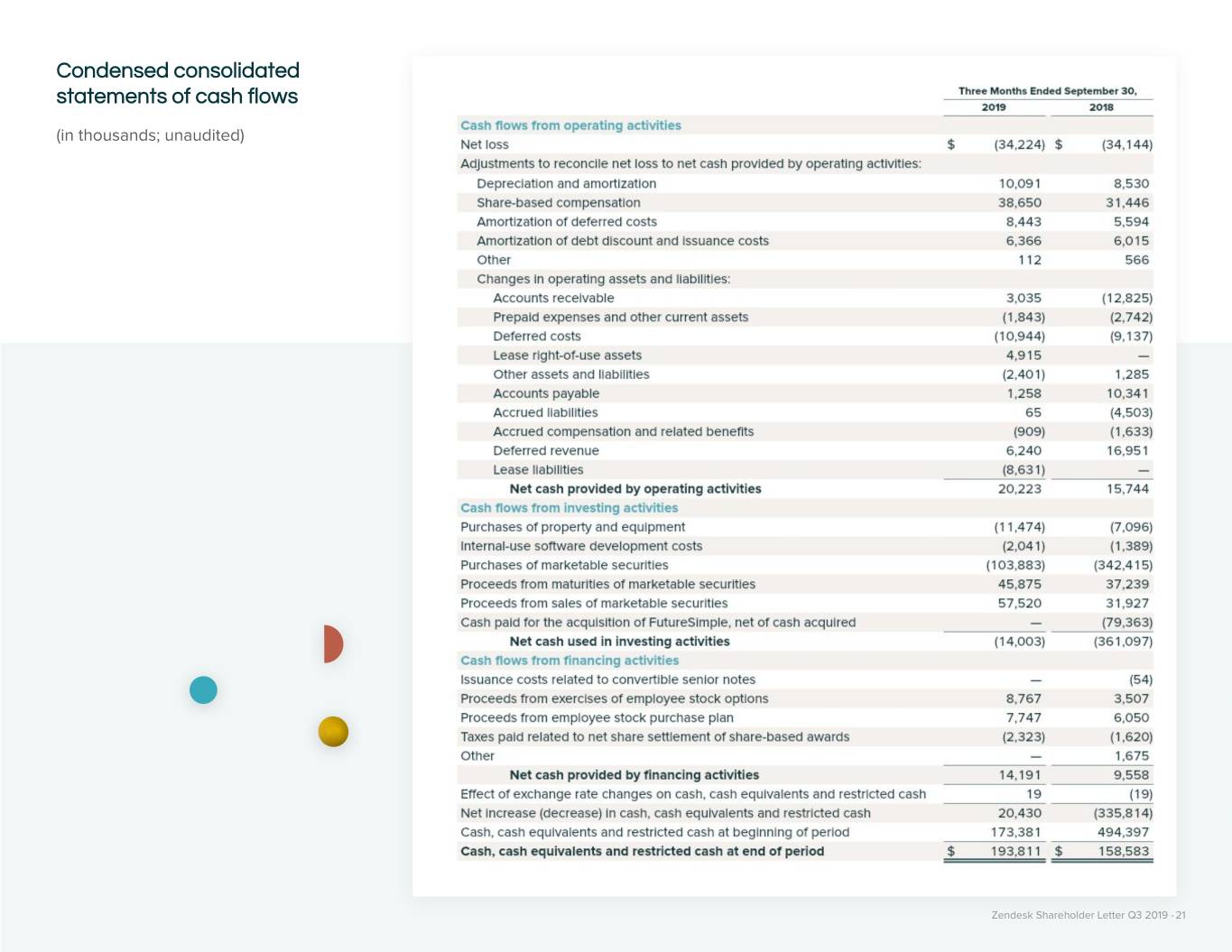
Condensed consolidated statements of cash flows (in thousands; unaudited) Zendesk Shareholder Letter Q3 2019 - 21
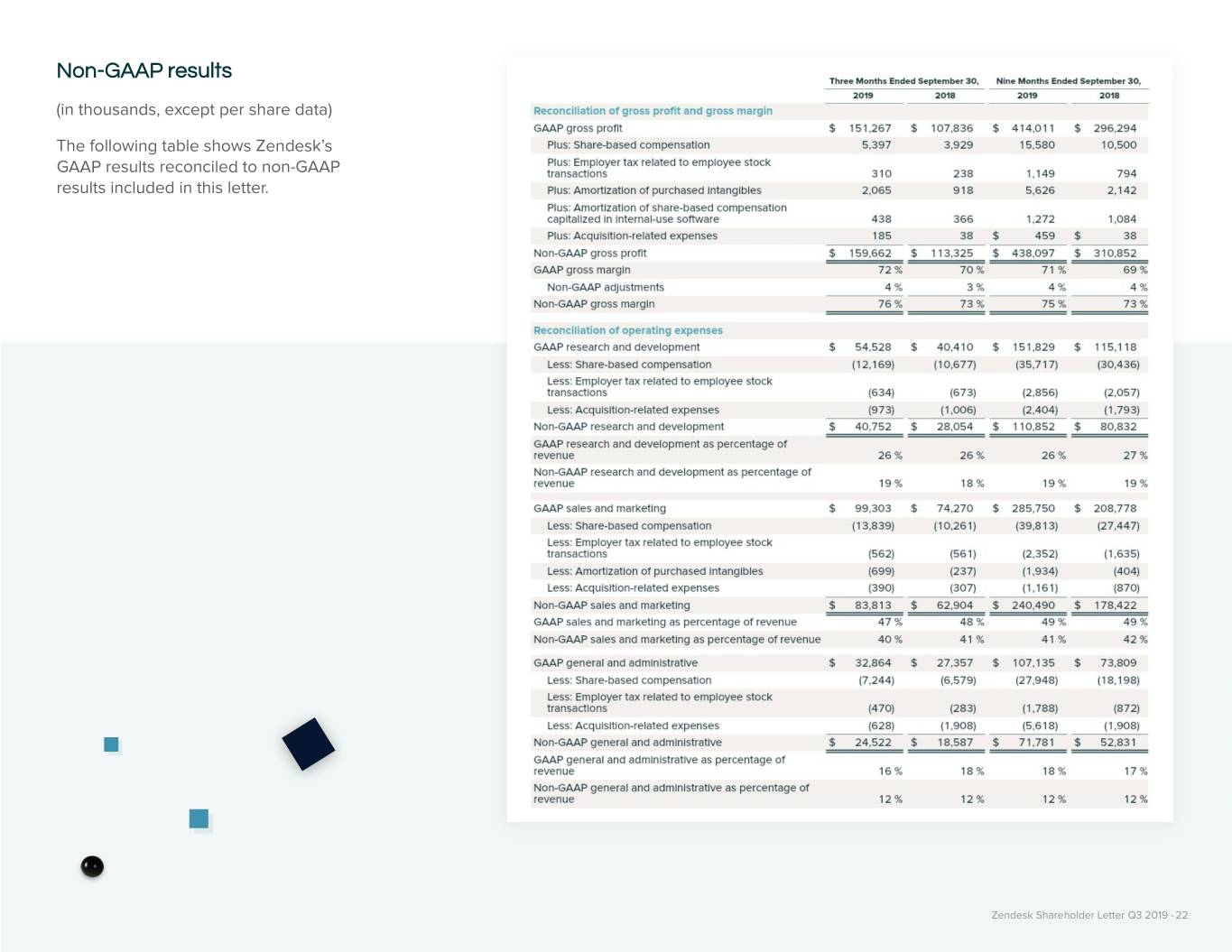
Non-GAAP results (in thousands, except per share data) The following table shows Zendesk’s GAAP results reconciled to non-GAAP results included in this letter. Zendesk Shareholder Letter Q3 2019 - 22

Non-GAAP results (continued) (in thousands, except per share data) The following table shows Zendesk’s GAAP results reconciled to non-GAAP results included in this letter. Zendesk Shareholder Letter Q3 2019 - 23
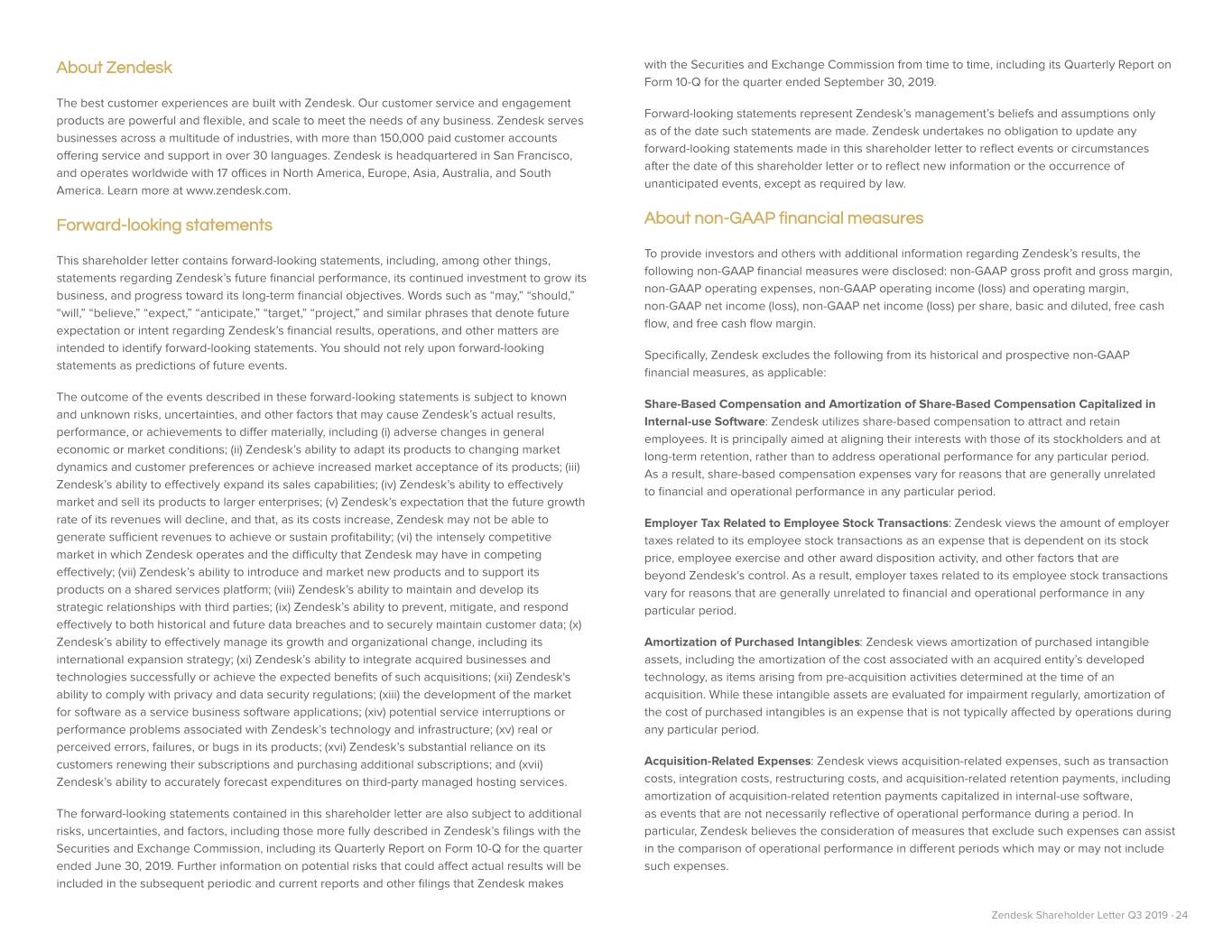
About Zendesk with the Securities and Exchange Commission from time to time, including its Quarterly Report on Form 10-Q for the quarter ended September 30, 2019. The best customer experiences are built with Zendesk. Our customer service and engagement Forward-looking statements represent Zendesk’s management’s beliefs and assumptions only products are powerful and flexible, and scale to meet the needs of any business. Zendesk serves as of the date such statements are made. Zendesk undertakes no obligation to update any businesses across a multitude of industries, with more than 150,000 paid customer accounts forward-looking statements made in this shareholder letter to reflect events or circumstances offering service and support in over 30 languages. Zendesk is headquartered in San Francisco, after the date of this shareholder letter or to reflect new information or the occurrence of and operates worldwide with 17 offices in North America, Europe, Asia, Australia, and South unanticipated events, except as required by law. America. Learn more at www.zendesk.com. About non-GAAP financial measures Forward-looking statements To provide investors and others with additional information regarding Zendesk’s results, the This shareholder letter contains forward-looking statements, including, among other things, following non-GAAP financial measures were disclosed: non-GAAP gross profit and gross margin, statements regarding Zendesk’s future financial performance, its continued investment to grow its non-GAAP operating expenses, non-GAAP operating income (loss) and operating margin, business, and progress toward its long-term financial objectives. Words such as “may,” “should,” non-GAAP net income (loss), non-GAAP net income (loss) per share, basic and diluted, free cash “will,” “believe,” “expect,” “anticipate,” “target,” “project,” and similar phrases that denote future flow, and free cash flow margin. expectation or intent regarding Zendesk’s financial results, operations, and other matters are intended to identify forward-looking statements. You should not rely upon forward-looking Specifically, Zendesk excludes the following from its historical and prospective non-GAAP statements as predictions of future events. financial measures, as applicable: The outcome of the events described in these forward-looking statements is subject to known Share-Based Compensation and Amortization of Share-Based Compensation Capitalized in and unknown risks, uncertainties, and other factors that may cause Zendesk’s actual results, Internal-use Software: Zendesk utilizes share-based compensation to attract and retain performance, or achievements to differ materially, including (i) adverse changes in general employees. It is principally aimed at aligning their interests with those of its stockholders and at economic or market conditions; (ii) Zendesk’s ability to adapt its products to changing market long-term retention, rather than to address operational performance for any particular period. dynamics and customer preferences or achieve increased market acceptance of its products; (iii) As a result, share-based compensation expenses vary for reasons that are generally unrelated Zendesk’s ability to effectively expand its sales capabilities; (iv) Zendesk’s ability to effectively to financial and operational performance in any particular period. market and sell its products to larger enterprises; (v) Zendesk’s expectation that the future growth rate of its revenues will decline, and that, as its costs increase, Zendesk may not be able to Employer Tax Related to Employee Stock Transactions: Zendesk views the amount of employer generate sufficient revenues to achieve or sustain profitability; (vi) the intensely competitive taxes related to its employee stock transactions as an expense that is dependent on its stock market in which Zendesk operates and the difficulty that Zendesk may have in competing price, employee exercise and other award disposition activity, and other factors that are effectively; (vii) Zendesk’s ability to introduce and market new products and to support its beyond Zendesk’s control. As a result, employer taxes related to its employee stock transactions products on a shared services platform; (viii) Zendesk’s ability to maintain and develop its vary for reasons that are generally unrelated to financial and operational performance in any strategic relationships with third parties; (ix) Zendesk’s ability to prevent, mitigate, and respond particular period. effectively to both historical and future data breaches and to securely maintain customer data; (x) Zendesk’s ability to effectively manage its growth and organizational change, including its Amortization of Purchased Intangibles: Zendesk views amortization of purchased intangible international expansion strategy; (xi) Zendesk’s ability to integrate acquired businesses and assets, including the amortization of the cost associated with an acquired entity’s developed technologies successfully or achieve the expected benefits of such acquisitions; (xii) Zendesk's technology, as items arising from pre-acquisition activities determined at the time of an ability to comply with privacy and data security regulations; (xiii) the development of the market acquisition. While these intangible assets are evaluated for impairment regularly, amortization of for software as a service business software applications; (xiv) potential service interruptions or the cost of purchased intangibles is an expense that is not typically affected by operations during performance problems associated with Zendesk’s technology and infrastructure; (xv) real or any particular period. perceived errors, failures, or bugs in its products; (xvi) Zendesk’s substantial reliance on its customers renewing their subscriptions and purchasing additional subscriptions; and (xvii) Acquisition-Related Expenses: Zendesk views acquisition-related expenses, such as transaction Zendesk’s ability to accurately forecast expenditures on third-party managed hosting services. costs, integration costs, restructuring costs, and acquisition-related retention payments, including amortization of acquisition-related retention payments capitalized in internal-use software, The forward-looking statements contained in this shareholder letter are also subject to additional as events that are not necessarily reflective of operational performance during a period. In risks, uncertainties, and factors, including those more fully described in Zendesk’s filings with the particular, Zendesk believes the consideration of measures that exclude such expenses can assist Securities and Exchange Commission, including its Quarterly Report on Form 10-Q for the quarter in the comparison of operational performance in different periods which may or may not include ended June 30, 2019. Further information on potential risks that could affect actual results will be such expenses. included in the subsequent periodic and current reports and other filings that Zendesk makes Zendesk Shareholder Letter Q3 2019 - 24

Amortization of Debt Discount and Issuance Costs: In March 2018, Zendesk issued $575 million compensation and related expenses in Zendesk’s cost of revenue, amortization of purchased of convertible senior notes due in 2023, which bear interest at an annual fixed rate of 0.25%. The intangibles primarily related to developed technology, and acquisition-related expenses. The imputed interest rate of the convertible senior notes was approximately 5.26%. This is a result of share-based compensation and related expenses excluded due to such adjustments are primarily the debt discount recorded for the conversion feature that is required to be separately accounted comprised of the share-based compensation and related expenses for employees associated for as equity, and debt issuance costs, which reduce the carrying value of the convertible debt with Zendesk’s infrastructure and customer experience organization. instrument. The debt discount is amortized as interest expense together with the issuance costs of the debt. The expense for the amortization of debt discount and debt issuance costs is a Zendesk does not provide a reconciliation of its non-GAAP gross margin guidance to GAAP gross non-cash item, and we believe the exclusion of this interest expense will provide for a more useful margin for future periods because Zendesk does not provide guidance on the reconciling items comparison of our operational performance in different periods. between GAAP gross margin and non-GAAP gross margin, as a result of the uncertainty regarding, and the potential variability of, these items. The actual amount of such reconciling Income Tax Effects: Zendesk utilizes a fixed long-term projected tax rate in its computation items will have a significant impact on Zendesk’s non-GAAP gross margin and, accordingly, a of non-GAAP income tax effects to provide better consistency across interim reporting periods. In reconciliation of GAAP gross margin to non-GAAP gross margin guidance for the period is not projecting this long-term non-GAAP tax rate, Zendesk utilizes a financial projection that excludes available without unreasonable effort. the direct impact of other non-GAAP adjustments. The projected rate considers other factors such as Zendesk’s current operating structure, existing tax positions in various jurisdictions, and key Zendesk uses non-GAAP financial information to evaluate its ongoing operations and for internal legislation in major jurisdictions where Zendesk operates. For the year ending December 31, planning and forecasting purposes. Zendesk’s management does not itself, nor does it suggest 2019, Zendesk has determined the projected non-GAAP tax rate to be 21%. Zendesk will that investors should, consider such non-GAAP financial measures in isolation from, or as a periodically re-evaluate this tax rate, as necessary, for significant events, based on relevant tax substitute for, financial information prepared in accordance with GAAP. Zendesk presents such law changes, material changes in the forecasted geographic earnings mix, and any significant non-GAAP financial measures in reporting its financial results to provide investors with an acquisitions. additional tool to evaluate Zendesk’s operating results. Zendesk believes these non-GAAP financial measures are useful because they allow for greater transparency with respect to key Zendesk provides disclosures regarding its free cash flow, which is defined as net cash from metrics used by management in its financial and operational decision-making. This allows operating activities, less purchases of property and equipment and internal-use software investors and others to better understand and evaluate Zendesk’s operating results and future development costs. Free cash flow margin is calculated as free cash flow as a percentage of total prospects in the same manner as management. revenue. Zendesk uses free cash flow, free cash flow margin, and other measures, to evaluate the ability of its operations to generate cash that is available for purposes other than capital Zendesk’s management believes it is useful for itself and investors to review, as applicable, both expenditures and capitalized software development costs. Zendesk believes that information GAAP information that may include items such as share-based compensation and related regarding free cash flow and free cash flow margin provides investors with an important expenses, amortization of debt discount and issuance costs, amortization of purchased perspective on the cash available to fund ongoing operations. intangibles, and acquisition-related expenses, and the non-GAAP measures that exclude such information in order to assess the performance of Zendesk’s business and for planning and Zendesk has not reconciled free cash flow guidance to net cash from operating activities for the forecasting in subsequent periods. When Zendesk uses such a non-GAAP financial measure with year ending December 31, 2019 because Zendesk does not provide guidance on the reconciling respect to historical periods, it provides a reconciliation of the non-GAAP financial measure to the items between net cash from operating activities and free cash flow, as a result of the uncertainty most closely comparable GAAP financial measure. When Zendesk uses such a non-GAAP regarding, and the potential variability of, these items. The actual amount of such reconciling financial measure in a forward-looking manner for future periods, and a reconciliation is not items will have a significant impact on Zendesk’s free cash flow and, accordingly, a reconciliation determinable without unreasonable effort, Zendesk provides the reconciling information that is of net cash from operating activities to free cash flow for the year ending December 31, 2019 is determinable without unreasonable effort and identifies the information that would need to be not available without unreasonable effort. added or subtracted from the non-GAAP measure to arrive at the most directly comparable GAAP measure. Investors are encouraged to review the related GAAP financial measures and the Zendesk does not provide a reconciliation of its non-GAAP operating margin guidance to GAAP reconciliation of these non-GAAP financial measures to their most directly comparable GAAP operating margin for future periods beyond the current fiscal year because Zendesk does not financial measure as detailed above. provide guidance on the reconciling items between GAAP operating margin and non-GAAP operating margin for such periods, as a result of the uncertainty regarding, and the potential Non-GAAP gross margin for the second quarter of 2019 excludes $6.1 million in share-based variability of, these items. The actual amount of such reconciling items will have a significant compensation and related expenses (including $0.4 million of amortization of share-based impact on Zendesk’s non-GAAP operating margin and, accordingly, a reconciliation of GAAP compensation capitalized in internal-use software and $0.4 million of employer tax related to operating margin to non-GAAP operating margin guidance for such periods is not available employee stock transactions), $1.9 million of amortization of purchased intangibles, and $0.2 without unreasonable effort. million of acquisition-related expenses. Non-GAAP operating loss and non-GAAP operating margin for the second quarter of 2019 exclude $46.8 million in share-based compensation and Zendesk’s disclosures regarding its expectations for its non-GAAP gross margin include related expenses (including $2.7 million of employer tax related to employee stock transactions adjustments to its expectations for its GAAP gross margin that exclude share-based Zendesk Shareholder Letter Q3 2019 - 25
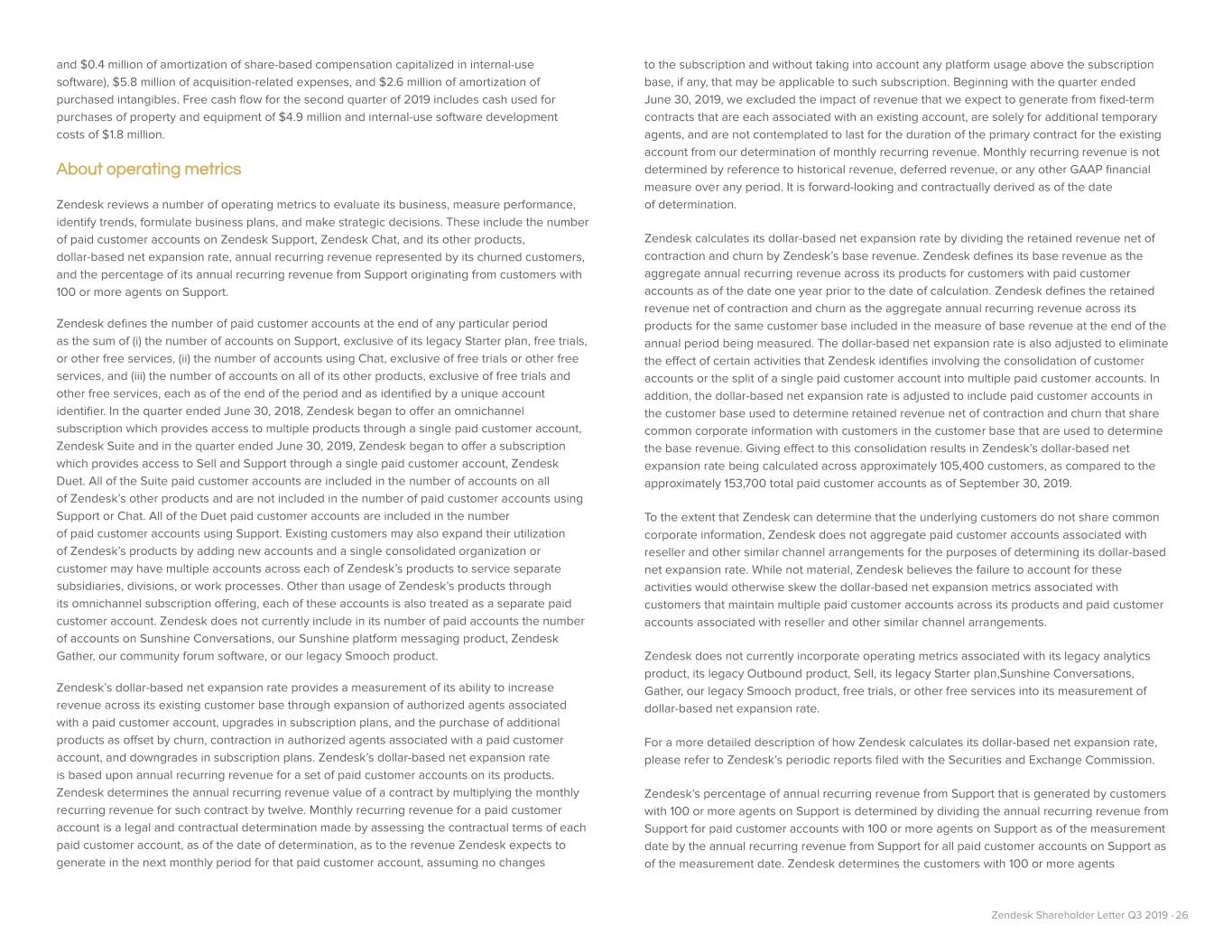
and $0.4 million of amortization of share-based compensation capitalized in internal-use to the subscription and without taking into account any platform usage above the subscription software), $5.8 million of acquisition-related expenses, and $2.6 million of amortization of base, if any, that may be applicable to such subscription. Beginning with the quarter ended purchased intangibles. Free cash flow for the second quarter of 2019 includes cash used for June 30, 2019, we excluded the impact of revenue that we expect to generate from fixed-term purchases of property and equipment of $4.9 million and internal-use software development contracts that are each associated with an existing account, are solely for additional temporary costs of $1.8 million. agents, and are not contemplated to last for the duration of the primary contract for the existing account from our determination of monthly recurring revenue. Monthly recurring revenue is not About operating metrics determined by reference to historical revenue, deferred revenue, or any other GAAP financial measure over any period. It is forward-looking and contractually derived as of the date Zendesk reviews a number of operating metrics to evaluate its business, measure performance, of determination. identify trends, formulate business plans, and make strategic decisions. These include the number of paid customer accounts on Zendesk Support, Zendesk Chat, and its other products, Zendesk calculates its dollar-based net expansion rate by dividing the retained revenue net of dollar-based net expansion rate, annual recurring revenue represented by its churned customers, contraction and churn by Zendesk’s base revenue. Zendesk defines its base revenue as the and the percentage of its annual recurring revenue from Support originating from customers with aggregate annual recurring revenue across its products for customers with paid customer 100 or more agents on Support. accounts as of the date one year prior to the date of calculation. Zendesk defines the retained revenue net of contraction and churn as the aggregate annual recurring revenue across its Zendesk defines the number of paid customer accounts at the end of any particular period products for the same customer base included in the measure of base revenue at the end of the as the sum of (i) the number of accounts on Support, exclusive of its legacy Starter plan, free trials, annual period being measured. The dollar-based net expansion rate is also adjusted to eliminate or other free services, (ii) the number of accounts using Chat, exclusive of free trials or other free the effect of certain activities that Zendesk identifies involving the consolidation of customer services, and (iii) the number of accounts on all of its other products, exclusive of free trials and accounts or the split of a single paid customer account into multiple paid customer accounts. In other free services, each as of the end of the period and as identified by a unique account addition, the dollar-based net expansion rate is adjusted to include paid customer accounts in identifier. In the quarter ended June 30, 2018, Zendesk began to offer an omnichannel the customer base used to determine retained revenue net of contraction and churn that share subscription which provides access to multiple products through a single paid customer account, common corporate information with customers in the customer base that are used to determine Zendesk Suite and in the quarter ended June 30, 2019, Zendesk began to offer a subscription the base revenue. Giving effect to this consolidation results in Zendesk’s dollar-based net which provides access to Sell and Support through a single paid customer account, Zendesk expansion rate being calculated across approximately 105,400 customers, as compared to the Duet. All of the Suite paid customer accounts are included in the number of accounts on all approximately 153,700 total paid customer accounts as of September 30, 2019. of Zendesk’s other products and are not included in the number of paid customer accounts using Support or Chat. All of the Duet paid customer accounts are included in the number To the extent that Zendesk can determine that the underlying customers do not share common of paid customer accounts using Support. Existing customers may also expand their utilization corporate information, Zendesk does not aggregate paid customer accounts associated with of Zendesk’s products by adding new accounts and a single consolidated organization or reseller and other similar channel arrangements for the purposes of determining its dollar-based customer may have multiple accounts across each of Zendesk’s products to service separate net expansion rate. While not material, Zendesk believes the failure to account for these subsidiaries, divisions, or work processes. Other than usage of Zendesk’s products through activities would otherwise skew the dollar-based net expansion metrics associated with its omnichannel subscription offering, each of these accounts is also treated as a separate paid customers that maintain multiple paid customer accounts across its products and paid customer customer account. Zendesk does not currently include in its number of paid accounts the number accounts associated with reseller and other similar channel arrangements. of accounts on Sunshine Conversations, our Sunshine platform messaging product, Zendesk Gather, our community forum software, or our legacy Smooch product. Zendesk does not currently incorporate operating metrics associated with its legacy analytics product, its legacy Outbound product, Sell, its legacy Starter plan,Sunshine Conversations, Zendesk’s dollar-based net expansion rate provides a measurement of its ability to increase Gather, our legacy Smooch product, free trials, or other free services into its measurement of revenue across its existing customer base through expansion of authorized agents associated dollar-based net expansion rate. with a paid customer account, upgrades in subscription plans, and the purchase of additional products as offset by churn, contraction in authorized agents associated with a paid customer For a more detailed description of how Zendesk calculates its dollar-based net expansion rate, account, and downgrades in subscription plans. Zendesk’s dollar-based net expansion rate please refer to Zendesk’s periodic reports filed with the Securities and Exchange Commission. is based upon annual recurring revenue for a set of paid customer accounts on its products. Zendesk determines the annual recurring revenue value of a contract by multiplying the monthly Zendesk’s percentage of annual recurring revenue from Support that is generated by customers recurring revenue for such contract by twelve. Monthly recurring revenue for a paid customer with 100 or more agents on Support is determined by dividing the annual recurring revenue from account is a legal and contractual determination made by assessing the contractual terms of each Support for paid customer accounts with 100 or more agents on Support as of the measurement paid customer account, as of the date of determination, as to the revenue Zendesk expects to date by the annual recurring revenue from Support for all paid customer accounts on Support as generate in the next monthly period for that paid customer account, assuming no changes of the measurement date. Zendesk determines the customers with 100 or more agents Zendesk Shareholder Letter Q3 2019 - 26

on Support as of the measurement date based on the number of activated agents on Support at the measurement date and includes adjustments to aggregate paid customer accounts that share common corporate information. For the purpose of determining this metric, Zendesk builds an estimation of the proportion of annual recurring revenue from Suite attributable to Support and includes such portion in the annual recurring revenue from Support. Zendesk does not currently incorporate operating metrics associated with products other than Support into its measurement of the percentage of annual recurring revenue from Support that is generated by customers with 100 or more agents on Support. Zendesk’s annual revenue run rate is based on its revenue for the three months ended September 30, 2019. Zendesk annualized such results to estimate its annual revenue run rate by multiplying the revenue for the three months ended September 30, 2019 by four. Zendesk’s annual revenue run rate is not a comprehensive statement of its financial results for this period and should not be viewed as a substitute for full annual or interim financial statements prepared in accordance with GAAP. In addition, Zendesk’s revenue for the three months ended September 30, 2019 or annual revenue run rate are not necessarily indicative of the results to be achieved in any future period. Zendesk Shareholder Letter Q3 2019 - 27

Customer metrics *May not add up to total due to rounding Geographic information Revenue mix by geography Contact Investor contact Karen Sansot +1 415-852-3877 ir@zendesk.com Media contact 8.3% Tian Lee +1 415-231-0847 press@zendesk.com Source: Zendesk, Inc. Zendesk Shareholder Letter Q3 2019 - 28



























